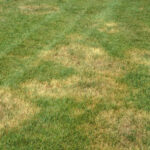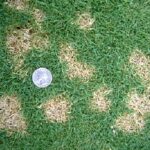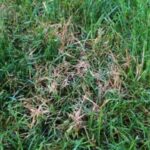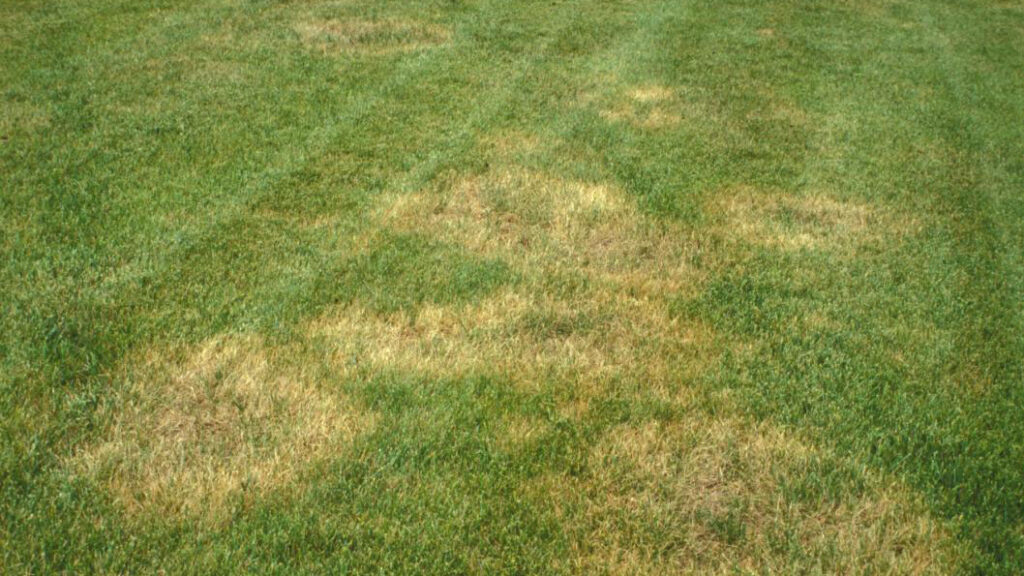With the warm temperatures, ample rainfall, and high humidity this spring, Carmel, Indiana lawn’s endured prolonged periods of perfect weather conditions for lawn disease and fungus. We are seeing a variety of lawn fungal diseases this year – from dead-looking brown patches to highly visible spots, threads, rings, or slimes. And once they strike your yard, grass fungal diseases can be
difficult to treat. Fungal turf diseases are very common throughout the Carmel, Indiana area and can leave your lawn looking brown or burnt and in some cases, permanently kill the grass all together. In the midwest, the most common of these diseases are Brown Patch, Dollar Spot, Pythium blight, leaf spot diseases, and the appearance of symptoms of summer patch and necrotic ring spot.
PREVENTION
Certainly grass type and soil quality are important when it comes to having a beautiful lawn, but it’s the ongoing care – watering, mowing, fertilizing, etc that has the most impact. Upwards of 80% of yard issues are caused by homeowners and most of those are related to irrigation, typically over-watering. We all know that plants need water but often fall victim to the thinking that if some is good, more is better. Many of us have also invested our hard earned dollars into irrigation systems and want to see them put to use. Mowing the grass too short can also make the lawn more susceptible to compounding issues. Stressed plants emit pheromones which attract bugs, wet thatch encourages disease and overfeeding can inspire the growth of unwanted plant and fungal species. To learn more about watering and mowing guidelines, check out this Spring Checklist to get your lawn healthy before the heat of summer.
TURF DISEASES
If you have turf, it is at risk of turf disease. Soil microbes are naturally occurring and exist in all soil. These generally work symbiotically with plants but when certain environmental conditions are met, they react and can cause lawn fungus or disease damage. Three things are necessary for turf diseases to become active:
-
Pathogen – naturally occurring in the soil (soil is mandatory for a lawn)
-
Host – grass is the host (grass is mandatory for a lawn)
-
Environment – temperature, wetness, and humidity all play a role; when the right conditions of all three are present at the same time, some diseases thrive (the natural environment is impossible to control but you can take steps such as following proper watering guidelines, removing thatch and improving drainage to counter ground wetness)
Brown Patch & Dollar Spot

Symptom Descriptions: My grass was green but now has circular brown patches; the patch started about aliens made crop circles in my lawn.the size of a coffee cup butis radiating out equidistantly; some of the patches may be overlapping each other; my cousin is convinced aliens made crop circles in my lawn.
Grass Affected: all grass types are susceptible to Brown Patch and Take All Patch
 About Brown Patch & Dollar Spot: Both diseases are caused by naturally occurring, soil borne fungi, when conditions are warm and wet. The symptoms are nearly identical and are most common when temperatures are 70-90+ degrees Fahrenheit and humidity level reaches 70% or greater. Lawns are most susceptible to these diseases when thatch (the area between the dirt and the green part of the grass) is wet for eight hours or more. Low spots or depressions in which water tends to collect are most likely to be affected as well as grass growing in soil which contains clay
About Brown Patch & Dollar Spot: Both diseases are caused by naturally occurring, soil borne fungi, when conditions are warm and wet. The symptoms are nearly identical and are most common when temperatures are 70-90+ degrees Fahrenheit and humidity level reaches 70% or greater. Lawns are most susceptible to these diseases when thatch (the area between the dirt and the green part of the grass) is wet for eight hours or more. Low spots or depressions in which water tends to collect are most likely to be affected as well as grass growing in soil which contains clay
Red Thread and Pink Patch
 Symptoms Descriptions:From a distance, Red Thread appears as pink to red patches from 4″ to 2 ft. in diameter. When observed more closely, you will see the reddish thread-like fungal structures on grass plants. When there is dew present on the lawn, you may even see small pink tufts on these spots as well. As the fungus grows, smaller spots may turn into larger ones as they connect together to form larger irregularly-shaped areas.
Symptoms Descriptions:From a distance, Red Thread appears as pink to red patches from 4″ to 2 ft. in diameter. When observed more closely, you will see the reddish thread-like fungal structures on grass plants. When there is dew present on the lawn, you may even see small pink tufts on these spots as well. As the fungus grows, smaller spots may turn into larger ones as they connect together to form larger irregularly-shaped areas.
The most effective way to get rid of Red Thread is to address the susceptible host plant. Fertilizing lawns in late spring and early summer will help to provide nitrogen. As that nitrogen gets watered in, most lawns will grow-out this specific turf disease problem. That being said, there are instances where Red Thread can become a chronic problem or advance past normal levels and a fungicide treatment may be required. This isn’t typical, but it can happen.
TREATMENT
Treatments for most turf diseases include a combination of fungicides and an adaptation to the lawn itself including strategies to rid excess moisture: thatch removal, irrigation improvements, changes to watering protocols, etc. Depending on the type of disease, some treatments should be followed up with applications of fertilizer while other should not. A lot of people think fungicides don’t work, when in fact, they didn’t use the product correctly. Learn how to properly apply fungicides for the best results at https://www.youtube.com/watch?v=M8-1xfo243Y by Purdue University Landscape Report.
Having a properly executed lawn care program and a lawn care company that employs true lawn care experts can help with your Red Thread issues. Lawn care programs that deliver a steady amount of nitrogen throughout the year, particularly in the times of probably infection, will help your grass to push out this specific disease. Your lawn expert can also let you know if your situation would warrant the extra help of a lawn disease control treatment for Red Thread. Some turf diseases are aggravated by excessive fertilization so be sure to have an expert diagnose which disease your lawn is facing before fertilizing your lawn. If you need help diagnosing or treating a turf disease or other lawn care problem, please don’t hesitate to contact us.
Topics: lawn care







